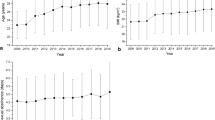Abstract
Purpose : To determine whether the quality of semen has changed over time in men screened for semen donation.
Methods : All 448 men volunteering for semen donation between 1983 and 2001 at a donor insemination clinic in Sydney, Australia, were included in this longitudinal single centre observational analysis of semen parameters. There was no selection for fertility or marital status but all volunteers had to be aged between 18 and 40 years.
Results : There was no change in the total sperm count during the study period (r = 0.065, P = 0.17) using a linear regression model. The ejaculate volume did not change (r = 0.002, P = 0.97), while an increase in sperm motility was seen (Spearman R = 0.194, P < 0.001).
Conclusion : The semen quality of volunteers for sperm donation presenting to our donor insemination clinic in Sydney between 1983 and 2001 has not declined.
Similar content being viewed by others
REFERENCES
Macomber D, Saunders M: The spermatozoa count: Its value in the diagnosis, prognosis and treatment of sterility. Engl J Med 1929;200:981-984
Hammen R: Studies on Impaired Fertility in Man with Special Reference to the Male. Copenhagen, Einar Munksgaard, 1944
MacLeod J, Heim LM: Characteristics and variations in semen specimens in 100 normal young men. J Urol 1945;54:474-482
World Health Organization: Laboratory Manual for the Examination of Human Semen and Sperm-Cervical Mucus Interaction. Cambridge, Cambridge University Press, 1999
Carlsen E, Giwercman A, Keiding N, Skakkebaek NE: Evidence for decreasing quality of semen during the past 50 years. BMJ 1992;305:609-613
Sharpe RM, Skakkebaek NE: Are oestrogens involved in falling sperm counts and disorders of the male reproductive tract? Lancet 1993;341:1392-1396
Kavlock RJ, Daston GP, DeRosa C: Research needs for the risk assessment of health and environmental effects of endocrine disruptors: A report of the U.S. EPA-sponsored workshop. Environ Health Perspect 1996;104(Suppl 4):715-740
Auger J, Kunstmann JM, Czyglik F, Jouannet P: Decline in semen quality among fertile men in Paris during the past 20 years. N Engl J Med 1995;332:281-285
Adamopoulos DA, Pappa A, Nicopoulou S, Andreou E, Karamertzanis M, Michopoulos J, Deligianni V, Simou M: Seminal volume and total sperm number trends in men attending subfertility clinics in the greater Athens area during the period 1977-1993. Hum Reprod 1996;11:1936-1941
Irvine S, Cawood E, Richardson D, MacDonald E, Aitken J: Evidence of deteriorating semen quality in the United Kingdom: Birth cohort study in 577 men in Scotland over 11 years. BMJ 1996;312:467-471
Van Waeleghem K, De Clercq N, Vermeulen L, Schoonjans F, Comhaire F: Deterioration of sperm quality in young healthy Belgian men. Hum Reprod 1996;11:325-329
Bujan L, Mansat A, Pontonnier F, Mieusset R: Time series analysis of sperm concentration in fertile men in Toulouse, France between 1977 and 1992. BMJ 1996;312:471-472
Fisch H, Goluboff ET, Olson JH, Feldshuh J, Broder SJ, Barad DH: Semen analyses in 1283 men from the United States over a 25 year period: No decline in quality. Fertil Steril 1996;65:1009-1014
Paulsen C, Berman N, Wang C: Data from men in greater Seattle area reveals no downward trend in semen quality: Further evidence that deterioration of semen quality is not geographically uniform. Fertil Steril 1996;65:1015-1020
Benshushan A, Shoshani O, Paltiel O, Schenker JG, Lewin A: Is there really a decrease in sperm parameters among healthy young men? A survey of sperm donations during 15 years. J Assist Reprod Genet 1997;14:347-353
World Health Organization: Laboratory Manual for the Examination of Human Semen and Sperm-Cervical Mucus Interaction. Singapore, Press Concern, 1980
World Health Organization: Laboratory Manual for the Examination of Human Semen and Sperm-Cervical Mucus Interaction. Cambridge, Cambridge University Press, 1987
World Health Organization: Laboratory Manual for the Examination of Human Semen and Sperm-Cervical Mucus Interaction. Cambridge, Cambridge University Press, 1992
Kidd SA, Eskenazi B, Wyrobek AJ: Effects of male age on semen quality and fertility: A review of the literarure. Fertil Steril 2001;75:237-248
Handelsman DJ: Sperm output of healthy men in Australia: Magnitude of bias due to self-selected volunteers.HumReprod 1997;12:2701-2705
Hendelsman DJ, Conway AJ, Boylan LM, Turtle JR: Testicular function in potential sperm donors: Normal ranges and the effects of smoking and varicocele. Int J Androl 1984;7:369-382
Olsen GW, Bodner KM, Ramlow JM, Ross CE, Lipshultz LI: Have sperm counts been reduced 50 percent in 50 years? A statistical model revisited. Fertil Steril 1995;63:887-893
Fisch H, Goluboff ET: Geographic variations in sperm counts: Apotential cause of bias in studies of semen quality.Fertil Steril 1996;65:1044-1046
Larsen S, Abell A, Bonde JP: Selection bias in occupational sperm studies. Am J Epidemiol 1998;147:681-685
Tummon IS, Mortimer D: Decreasing quality of semen. BMJ 1992;305:1228-1229
Ginsburg J, Okolo S, Prelevic G, Hardiman P: Residence in the London area and sperm density. Lancet 1994;343:230
Suominen J, Vierula M: Semen quality of Finnish men. BMJ 1993;306:1579
Vierula M, Niemi M, Keiski A, Saaranen M, Saarikoski S, Suominen J: High and unchanged sperm counts of Finnish men. Int J Androl 1996;19:11-17
Stewart TM, Brown EH, Venn A, Mbizvo MT, Farley TMM, Garrett C, Baker HWG: Feasibility of surveillance of changes in human fertility and semen quality. Hum Reprod 2001;16:177-187
Setchell BP: Sperm counts in semen of farm animals 1932-1995. Int J Androl 1997;20:209-214
Handelsman DJ, Dunn SM, Conway AJ, Boylan LM, Jansen RP: Psychological and attitudinal profiles in donors for artificial insemination. Fertil Steril 1985;43:95-101
Farkas GM, Sine LF, Evans IM: Personality, sexuality, and demographic differences between volunteers and nonvolunteers for a laboratory study of male sexual behaviour. Arch Sex Behav 1978;7:513-520
Strassberg DS, Lowe K: Volunteer bias in sexuality research. Arch Sex Behav 1995;24:369-382
Author information
Authors and Affiliations
Corresponding author
Rights and permissions
About this article
Cite this article
Costello, M.F., Sjoblom, P., Haddad, Y. et al. No Decline in Semen Quality Among Potential Sperm Donors in Sydney, Australia, Between 1983 and 2001. J Assist Reprod Genet 19, 284–290 (2002). https://doi.org/10.1023/A:1015729314081
Issue Date:
DOI: https://doi.org/10.1023/A:1015729314081




